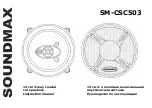
Portable Optical Tweezers Kit
Chapter 3: Principles of Optical Tweezers
Page 8
MTN024417-D02
𝑄𝑄
𝑆𝑆
=
𝑅𝑅
𝑟𝑟
sin
(
2
𝜃𝜃
)
−
𝑇𝑇
2
(
sin
(
2
𝜃𝜃 −
2
𝑡𝑡
)
+
𝑅𝑅
𝑟𝑟
sin
(
2
𝜃𝜃
))
1 +
𝑅𝑅
𝑟𝑟
2
+ 2
𝑅𝑅
𝑟𝑟
cos
(
2
𝑡𝑡
)
(16)
Here,
𝑡𝑡
is the angle at which the first transmitted beam is refracted toward the normal (see
Figure 2). According to Snell’s law of refraction, the following relationship is in effect for
the angles
𝜃𝜃
and
𝑡𝑡
:
sin
(
𝜃𝜃
)
sin
(
𝑡𝑡
)
=
𝑛𝑛
𝑝𝑝
𝑛𝑛
𝑚𝑚
(17)
𝑄𝑄
𝑡𝑡
and
𝑄𝑄
𝑆𝑆
are dimensionless Q factors, which state what percentage of the incident
momentum contributes to the force parallel or perpendicular to the beam, respectively.
These factors depend heavily on the angle of incidence of the beam, as one can see from
the equations. This angle becomes larger the more heavily the beam is focused, which
occurs when a higher numerical aperture objective is used.
The component of the beam that points in the incident direction (Z direction) ultimately
causes the scattering force
𝐹𝐹
𝑡𝑡
. The component perpendicular to this (Y direction) is mainly
responsible for the gradient force
𝐹𝐹
𝑆𝑆
.
In order to obtain the overall power, one must
naturally consider all partial beams and integrate all of them. That will be discussed in
detail below.
Q Factor Angular Dependence
Figure 3 shows the values of the two
𝑄𝑄 −
factors, depending upon the angle of incidence
𝜃𝜃
when the focus is located slightly above the surface of the sphere. One can see here
𝑄𝑄
𝑆𝑆
is negative through almost the entire range, meaning the force acts in the negative Y
Содержание EDU-OT3
Страница 1: ...EDU OT3 EDU OT3 M Portable Optical Tweezers User Guide...
Страница 93: ......
Страница 94: ...www thorlabs com...












































